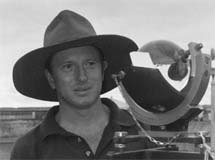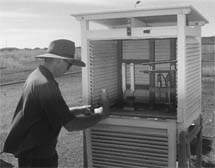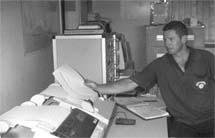The answers really are
blowin' in the wind
Weather man Russell Gillibrand explains how it's all done
What is this place called?
A Meteorological Information Office. It used to be called an Observing
Office when they were just observing, but now the bureau wants us to
get more involved in the community and provide a service to the community
and that is providing climatic or meteorological data.
What sort of things do you monitor here?
We monitor all the service conditions - wind speed, wind direction,
maximum wind gust, temperature, humidity, air pressure, changes in air
pressure, current weather, past weather, cloud types. We also do the
wind find radar by tracking the weather balloon to heights of up to
600 metres and from the details that the radar provides us with, we
can get wind speed and direction. All the details that we gather here
are then sent on the computer through the communication system to Melbourne
and Darwin and sometimes the information will go overseas, depending
on the type of information it is and who needs to find out what's going
on. My counterparts in Darwin will plot all that information on various
different sorts of charts and then provide it to the forecasters and
also the researchers in Melbourne who might use some of the data that
we gather. We also measure in here rainfall, soil temperatures - from
10cm, 20cm, 50cm and a metre below the ground and also evaporation.
So there are a fair few things that we do here. There are some fancy
offices in the Bureau's network that use radio sonds, which measure
air pressure, temperature and humidity all through the atmosphere. They
also do weather watch with their radars, so they can pick up storms.
This station operates twenty four hours a day but isn't staffed twenty
four hours a day. The automatic weather station, which is all our computer
gear, runs 24 hours a day. We normally work form 6:00 in the morning
to 3:00 in the afternoon and then 8:00 at night till 3:00 in the morning,
other times it's closed. But the information still goes out automatically
to the end user which is 9 times out of 10 the aviation industry, incoming
and outgoing aircraft will get the information provided for their flight
service through satellites and back down to ground stations and then
broadcast from text to voice, which is when the printed message is converted
to a voice, I've never heard it so I don't know what it sounds like
but I think it's relayed through satellites to the ground station. So
every 3 hours there is a forecast, we also get stuff by fax and from
over the Internet, the Bureau is trying to get more and more people
involved in the use of their service over the Internet.
So we do observations and provide a service to the public, for example
a person wanted rain and evaporation figures for an annual report they
are doing for their company, so we provide those and it is generally
a free service.
How many people work in the Tennant Creek office?
Three people work here but there's normally only one person on shift
at a time.
Why do you miss the 3:00am to 6:00am timeslot?
Lack of staff and it's probably not the most important part of the day
for the other users. Because most of the stuff we do is used by the
aviation industry.
The bigger stations such as those in Darwin and other capital cities
are open 24 hours, seven days a week regardless, they'll always have
someone on duty. At the military airports also, they'll always have
someone on duty, but because this is a small station, there isn't really
a need for full-time staff. If they had more staff and money then they
probably would have us on 24 hours a day and we would have better radars
and better equipment.
What sort of qualifications or study is involved
in becoming a meteorologist?
A meteorologist has to do a four year course at University, doing a
Batchelor of Science degree and also a 12 month course at the weather
bureau to be able to do the forecasting. People like me though, when
I joined I had a year 11 education with maths and physics and then a
nine month course at the Bureau's Training School. Now, they want people
in my position to have an Associate Diploma in computing and applied
physics and then go on to do the Bureau's course. But that's probably
going to change because like I said we don't really do much here except
press the button every half an hour and fill the weather balloons up,
and then the computer does the rest! It's nothing technical. And in
fact, the more automatic equipment that the Bureau brings in means that
in the future a contractor might get the job and they'll just come down
and fill the machines up, give them a pat on the head and off they go
again! It's a funny sort of thing, the qualifications are probably more
to do with the use of the computers rather than actually thinking about
the weather. Now it's too easy of you like, you don't have to think
about it so much. It's a bit of a disappointment really that it's gone
that way, but I suppose everybody's job eventually becomes more and
more automated and in return there becomes less and less to do.
What happens if there is a power failure and everything
shuts down?
Well we have supposedly got an Uninterrupted Power Supply, but there's
no such thing, as soon as you get bad weather they could just crash
or do funny things! The Bureau had the embarrassing situation last year
when they said they had record rainfall in Darwin, they had to turn
around say 'no, sorry it wasn't, our automatic machine has got it wrong!'
And one of the things that effects the machines is lightning, so it's
quite possible that when lightning hits, it zaps the machines and sent
them into doing all sorts of weird things! and they get some crappy
information back out of it, another price you pay for using technology.


Doing the rounds
of the measuring stations, here temperature.

Up, up and away.
Another balloon heads for the sky. The silver coating on the gondola
causes a radar echo which allows the Bureau to measure wind speed and
direction at various altitudes.

Machine-minding
in the computer room.